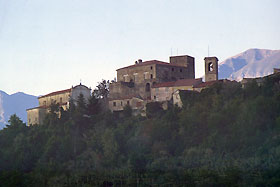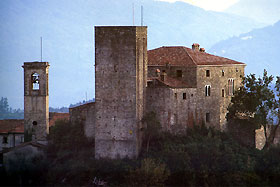Castiglione del Terziere
The ancient hamlet of Castiglione del Terziere in Lunigiana dominates
the valley of the Bagnone river, from a hill approximately 335 meters
high. It is reachable traveling throughout the Motorway A11 Firenze-Mare
until Lucca, then continuing on the A12 Genova-Livorno until the crossing
point with the A15 Parma-La Spezia. Leave the A15 at the exit 'Aulla'
and follow the SS62 until the town of Villafranca in Lunigiana, from here
follow the SP26 that lead to Bagnone. Just passed the village the road
begins to climb [after the bridge continue on the right] toward Castiglione.
The indications are clear.
» View a Map of the
Castle
 |
| The Porta Monumentale. |
Castiglione [from the 1275 century called 'del
Terziere' because it was comprised in the third part of the paternal
inheritance assigned to marquis Alberto Malaspina of the branch of Filattiera]
rises on the site of an ancient (6/7th century) Byzantine fortified
stronghold acting like remote defence of Luni.
The aspect of the village, dominated by the castle, dates for great part
back to the Middle Ages, when Castiglione, from the 10th to 12th century,
was fief of the Corbellari [Lords also of the nearby castle of Virgoletta]
that in 1202 yield it to the Malaspina. Its period of
maximum importance and development coincides with the domination of Castruccio
Castracani of the Alteminelli, commander and Lord of Lucca, that
made of Castiglione one of its strongholds pursuing the dream to unite
Lunigiana, Garfagnana, Lucchesia and Versilia in an only great state.
This plan never succeeded and the castle returned to have some importance
only from 1451, when it become center of the Florentine Captaincy
of Justice for the Lunigiana, thanks to its
ideal position to control important mountain roads of communication. The
castle was also the main strategic garrison along two
branch of Francigena Road, the first coming from Lucca and the other from
the mountains across the 'Passo di Tea', than had here their crossing
point.
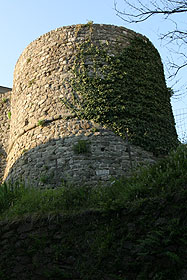 |
| Tower of Franceschino the Soldier. |
The original nucleus of the castle, dating to early
Middle Ages, is identifiable in the central keep,
encircled from what remains of the walled curtain. A
high square watch tower flanks it on the main, south-east,
front. This tower, that may be dated around the 12th century, strengthened
the most exposed flank and was connected 'at sight' with all the other
towers of the area. From the outside the keep is not today easy identifiable
because it's partially incorporated in successive constructions.
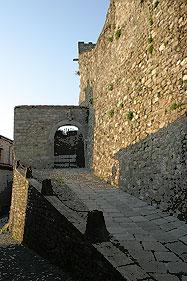 |
| The Main Castle Gate. |
With the coming of the Malaspina the castle was widened
and reinforced. Was Franceschino Malaspina, at the half
of 14th century, that strongly reconstruct the residential wing incorporating
the keep and the great circular tower called Torre di Franceschino
il Soldato 'Tower of Franceschino the Soldier',
at the center of the north-west front defending the main entrance. During
the three centuries of Florentine control the castle was progressively
adapted to its new function of residence for
the magistrates and employees of the Lordship. After a long period of
abandoning, from 1969 the castle belongs to Loris Jacopo Bononi,
that carried on its restoration, and today it accommodates the ' Center
of Humanistic Studies Niccolò V' with a rich historical
library.
It is impossible to speak of the castle without naming the village that
surround it. The original nucleus rises in the higher point of the hill,
along the road toward the castle. Still at the time of the Corbellari
dominion the first walled circuit enclosed the residential
units, but was with the Malaspina that Castiglione becomes an independent
fief and acquired its definitive appearance, developing itself along the
other main roads that, climbing the hill, lead to the castle. At the half
of the 1300 the whole settlement was encircled by the, second, walls and
equipped of two gates, that one called 'Alla Colla' at
northeast and the other 'In Cima Piagna' near the top
of the ridge. Under the Florentine were carried on also some rearrangement
at the country planning, the main road was embellished with beautiful
palaces in classical Renaissance style
[unfortunately today some are incredibly abandoned in a state of strongly
degradation!], as the house of the grain Merchants called 'del
Simonino', that others 'dei Torriani o Turriani'
of Milan and 'dei Corbellari' and others, the seat of
the Chancellery and a new gate called 'Monumentale'
with independent guardroom, erected at the cross point of the two main
road axis.
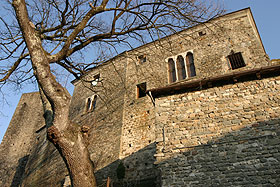 |
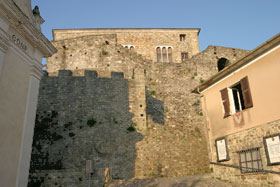 |
| The keep and the watchtower on the left. |
The main facade of the keep, then transformed in residential palace. |
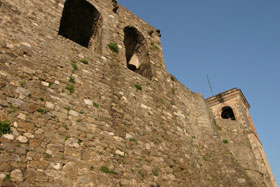 |
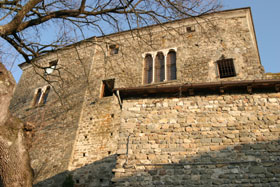 |
|
